Catocala of Maryland
Catocala nebulosa, Abingdon, Harford County, Maryland, September 12, 2009,
photographed at uv light in power line cut, courtesy of Kevin Harkins.
|
|
Updated as per "Systematics of moths in the genus Catocala (Lepidoptera, Erebidae) IV. Nomenclatorial stabilization of the Nearctic fauna, with a revised synonymic check list"; ZooKeys 39: 37–83 (2010) by Lawrence F. Gall, David C. Hawks; March 21, 2010 Updated as per August 22, 2015 for Dorchester County, courtesy of Jonathan Willey Updated as per personal communication with Jonathan Willey (Catocala minuta, Cambridge, Dorchester County, July 6, 2016); July 30, 2016 Updated as per personal communication with Jonathan Willey (Catocala agrippina, Cambridge, Dorchester County, August 6, 2016); August 7, 2016 Updated to include Catocala ulalume as per personal communication with Jonathan Willey, confirmed by Dr. Lawrence F. Gall, August 5, 2019 |
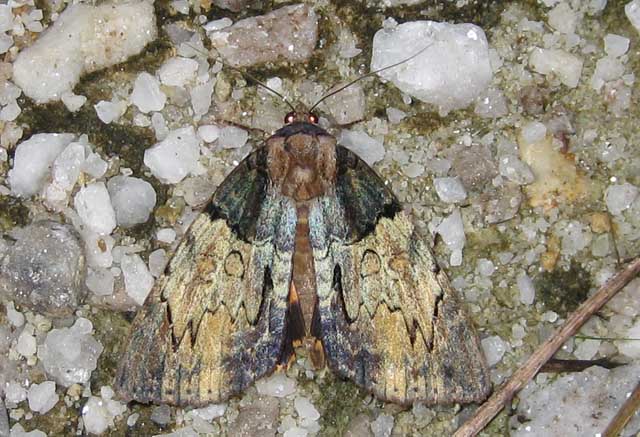
Catocala nebulosa, Abingdon, Harford County, Maryland, September 12, 2009,
photographed at uv light in power line cut, courtesy of Kevin Harkins.
Kevin writes, "I didn't know if you would be interested in some photographs that I took of a Catocala nebulosa underwing adult I attracted to a uv light set-up on the evening of September 12, 2009 in the middle of a powerline clearing in Abingdon, Maryland. A low pressure center, headed inland, came off the Atlantic Coast that Saturday. It was cloudy, humid, and spitting rain at the time I saw the moth flutter in from the adjacent mature forest. I took the photograph at around 10:30 pm. I had a tough time photographing the moth it was so active. When it stopped occasionally, the moth blended in so well with the gravel road that it made it tough to find. I'm not sure if you can use these photos for your site, happy hunting!"
This page is dedicated to Kevin Harkins and to Larry Line and John Glaser of Maryland, and to Larry Gall of Connecticut. Larry Line and John Glaser have provided data for Maryland, and Larry Gall has been a great help over the years with Catocala identifications and data.
Many thanks also to Mark Etheridge of Myersville, Frederick County, who has confirmed
both Catocala serena and Catocala obscura. Mark maintains a
Catocala website for his sightings in
Myersville. His data and some of his images have been used with permission.
As of April 4, 2010, this page has been further updated as per research data compiled by Larry Gall.
I would like to continue to refine the listings to county levels so images and data (date, location at least to county level,
bait, lights) would be very much appreciated. Please send same to Bill Oehlke.
All images that I use on my websites remain the property of respective photographers and images are credited as such.
Many thanks to Jonathan Willey who has sent me many sightings with data, confirmed with images for Dorchester County. Jonathan
sends this beautiful image of an unusual Catocala palaeogama phalanga with a very dark reniform spot.
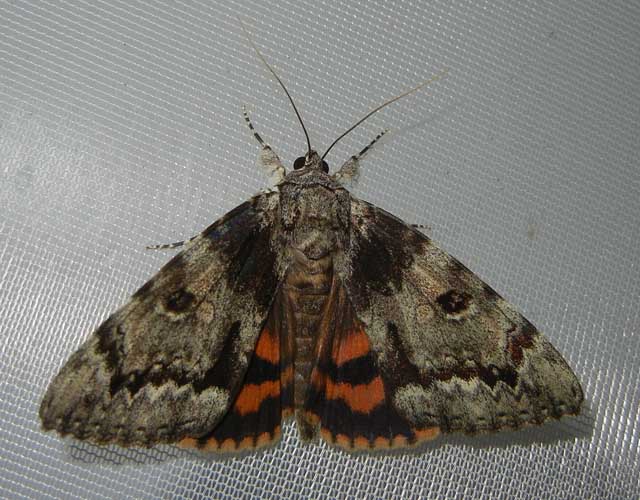
Catocala palaeogama form phalanga, Cambridge, Dorchester County, Maryland,
August 17, 2015, courtesy of Jonathan Willey.
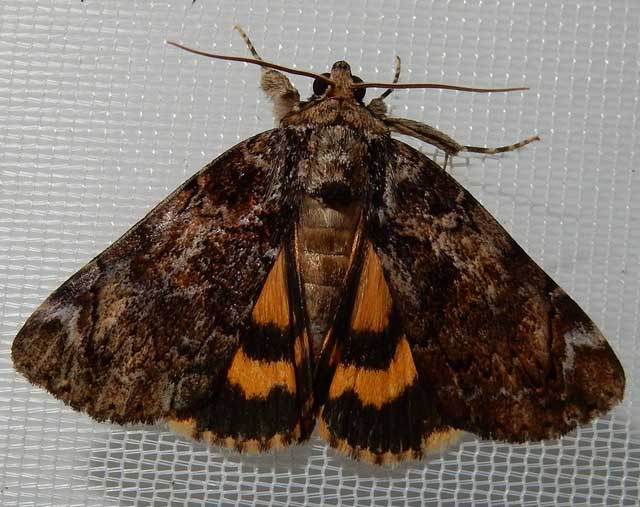
Catocala minuta, Cambridge, Dorchester County, Maryland,
July 6, 2016, courtesy of Jonathan Willey.
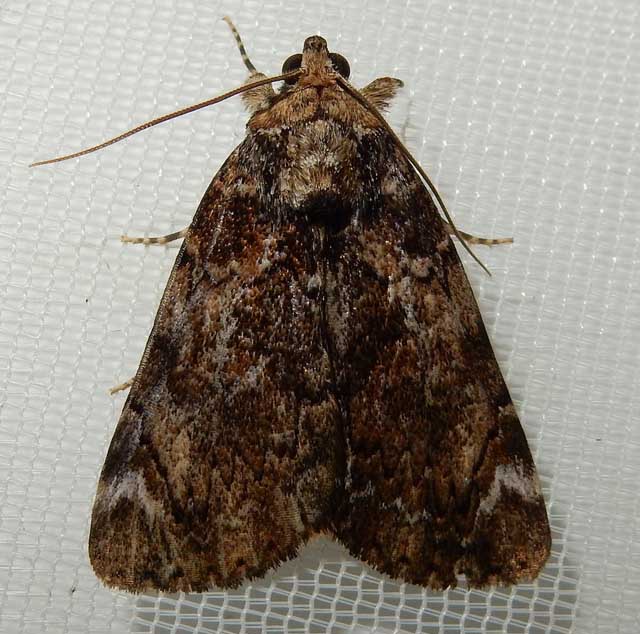
Catocala minuta, Cambridge, Dorchester County, Maryland,
July 6, 2016, courtesy of Jonathan Willey.
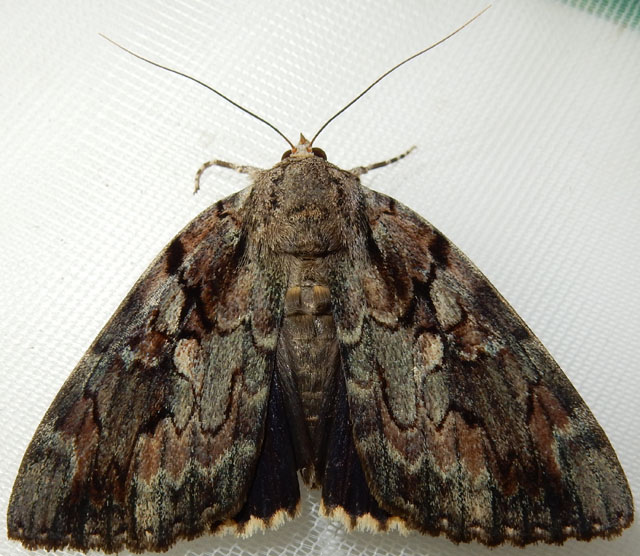
Catocala agrippina, Cambridge, Dorchester County, Maryland,
80mm, August 6, 2016, courtesy of Jonathan Willey.
On August 4, 2019, Jonathan Willey confirms (for the first time) Catocala ulalume in Maryland with the following image.
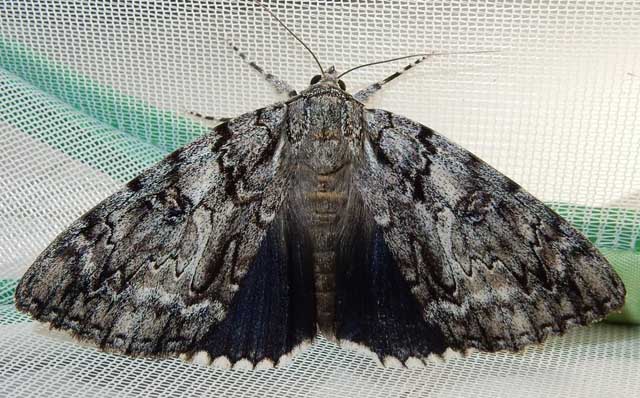
Visit Maryland Sphingidae: Hawk Moths/Sphinx Moths
Visit Tim Dyson Night Vision Photography: Ontario Catocala photographed at night, nectaring at fermenting fruit and in flight.
Little Yellow-Orange Underwings: Wingspans: 35-45mm
Common over State: Alleghany, Anne Arundel, Dorchester, Garrett, Harford, Washington; June 23rd to August 29th, LL
Big Savage Mountain, Garrett County, August 9th; Warrior Mountain WMA, Alleghany County, July 16th; Soldiers Delight, Baltimore County, July 30th (2), LL.
Little Yellow-Orange Underwings: Wingspans: 35-56mm |
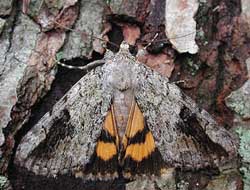
| ** 8876 Catocala micronympha, the Little Nymph Underwing, (wingspan: 35-50mm). John Himmelman image. Usual specimens have grey forewings shaded with green, brown, black and white tints. Usually a darkened band passing from costa through reniform spot to outer margin. High variability. Full size Joe Garris photo of C. micronympha form hero. |
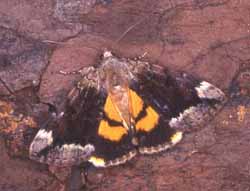
| ** 8876 Catocala micronympha form gisela, the Little Nymph Underwing, (wingspan: 35-50mm). The usual specimens have grey forewings shaded with green, brown, black and white tints. There is usually a darkened band passing from the costa through the reniform spot to the outer margin. Form "gisela" Meyer has a forewing that is mostly black. Leroy Simon image. |
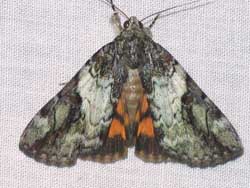
| ** 8876 Catocala micronympha form hero, the Little Nymph Underwing, (wingspan: 35-50mm). The usual specimens have grey forewings shaded with green, brown, black and white tints. There is usually a darkened band passing from the costa through the reniform spot to the outer margin. Form "hero" H. Edwards has a median area that is mostly white. Joe Garris image. |
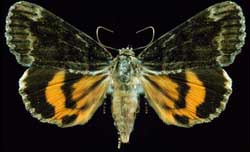
| ** 8876 Catocala micronympha form lolita, the Little Nymph Underwing, (wingspan: 35-50mm). Form "lolita" Sargent has very dark forewings.Harold J. Vermes image, used with permission from his son. |
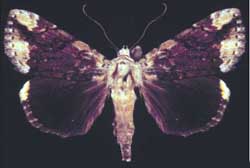
| ** 8876 Catocala micronympha form sargenti, the Little Nymph Underwing, (wingspan: 35-50mm). Usual specimens have grey forewings shaded with green, brown, black and white tints. Usually a darkened band passing from costa through reniform spot to outer margin. Form "sargenti" Covell (very rare) has hw all black. |
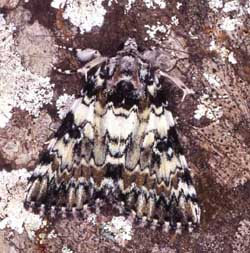
| ** 8877 connubialis, Connubial Underwing, (wingspan: 35-50mm). Fw highly variable; several forms: "sancta" Hulst; typical form, fws with white ground colour, sharply contrasting black lines, markings. Brown shading between postmedial and subterminal lines; "cordelia" H. Edwards, coloured as above, markings faint; "pulverulenta" Brower, grey-green forewings with faint markings, sometimes none; "broweri" Muller: melanic form, fws dark green, almost black. Hw has separate anal spot and outer band ends with straight cut. Leroy Simon image. |
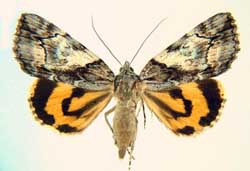
| Catocala pretiosa Precious Underwing; 40-50mm; Quite similar to crataegi and mira, but pretiosa has considerable creamy white colouration in median area. Lower portion of basal area light, not dark as in crataegi. THw inner black band forms loop and outer band is broken (not complete as in mira, followed by dot that tapers to anal angle. |
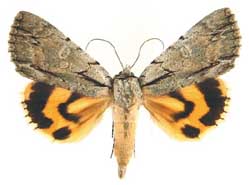
| ** 8772 clintoni unconfirmed; Clinton's Underwing, wingspan 45-55mm.The black basal dash distinguishes clintoni from illecta and abbreviatella, both of which lack the dash. Vernon Brou image. |
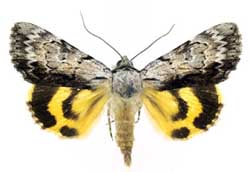
| ** 8847
gracilis,
Graceful Underwing, (wingspan: 40-45mm):
Gracilis closely resembles sordida but the hindwing loop is not
complete in gracilis as it is in sordida. |
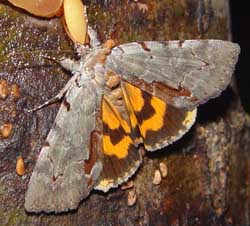
| ** 8864 Catocala grynea ; Woody Underwing, 40-50mm. Fw dull greenish grey with orangey-brown shading along inner margin. Antemedial, median and postmedial lines quite faint. Praeclara somewhat similar but has break in brown shading between am and pm lines. Praeclara also has paler orange hindwing color. |
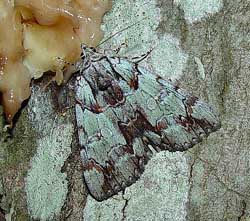
| ** 8865 praeclara; Praeclara Underwing, 40-50mm. Fw pale greenish-grey with considerable contrasting brown shading beyond post medial line. Black basal dash very close to inner margin and another dash, higher up in median area. Note contrasting shapes of reniform and subreniform spots. Upper of two larger pml teeth longer, wider than lower tooth. Note double, white filled amls. Lighter, subcircular patch, outlined in black, brown on lower thorax. |
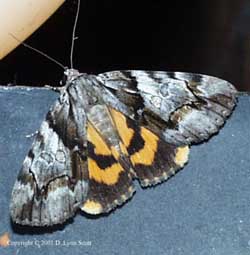
| ** 8867 Catocala blandula;
Charming Underwing, wingspan: 40-50mm. unconfirmed |
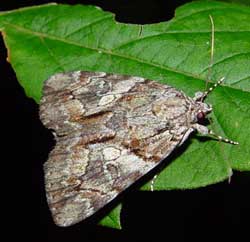
| Catocala mira; Wonderful Underwing, wingspan: 40-50mm: Fw pale basal area distinguishes mira from blandula (dark brown), crataegi (black). Fw lacks dark contrasting lines of crataegi, blandula. Considerable brown in subterminal area, subreniform spot very conspicuous, usually brown. Light area runs obliquely from costa to subreniform spot. Noticeable space along inner margin between am and pm lines. Hw is deep orange and has a complete inner black band. Outer black band is unbroken. Tim Dyson image. |
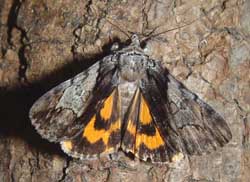
| ** 8858 Catocala crataegi WO; Hawthorn Underwing, wingspan: 40-50mm: Determination is based on dark (black) shading in forewing basal area continuing along inner margin to anal angle and brown shading beyond postmedial line. There is also a definite greenish cast to median area. Hw has outer black band, broken near the anal angle, distinguishing crataegi from blandula. Tim Dyson image. |
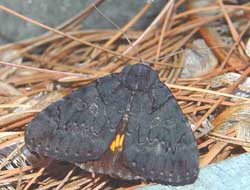
| ** 8775 antinympha; Sweetfern Underwing, wingspan 45-55mm unconfirmed: The very dark grey, almost black, forewing ground colour distinguishes antinympha. There is some brown shading in the subreniform spot and also just outside the postmedial line. The hindwing is amber to pale orange. There is also the form multoconspicua Reiff, 1919 with a pale, almost white subreniform spot. Tim Dyson image. |
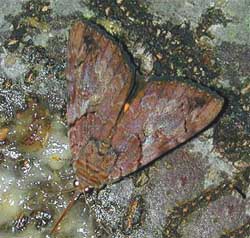
| ** 8774 muliercula; Little Wife Underwing, 54-70mm. The black bands of the hindwings tend to be very wide and there is considerable dark scaling along the inner margins. Hw fringe is very dark as is the general reddish-brown ground colour of the forewings.The forewing apex is preceded along the costa by a lighter, grey-brown patch. Steve Walter image. |
Midsized Orange-Salmon-Red-Scarlet Underwings: Wingspans: 50-72mm
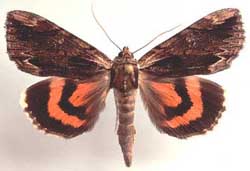
| ** 8857 Catocala ultronia; Ultronia Underwing, wingspan: 50-63mm.Fws typically gray-brown, with a distinct and very dark inner margin and characteristic light brown patch, underscored by very dark arc, near wingtip. Underwings can be yellow to orange to salmon. |
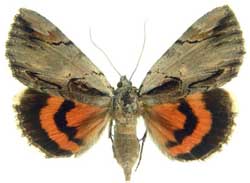
| ** 8857 Catocala ultronia form lucinda; Ultronia Underwing, wingspan: 50-63mm.In form lucinda most of the forewing is bright grey. On all forms there is
extensive orange-salmon colouration on hw ventral surface,
and there is a dark discal lunule. |
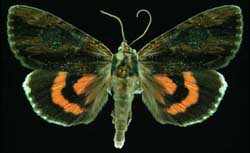
| Catocala ultronia, form nigrescens, the Ultronia Underwing, wingspan: 50-63mm. In the melanic form nigrescens, the dorsal forewing is very dark. Even darker subapical arc, basal dash and dash near anal angle are still visible. Dark basal hairs on hindwing. Harold J. Vermes slide, used with permission from his son. |
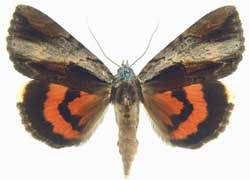
| Catocala ultronia form celia.
In form celia there is a wide, light grey band separating a dark region along inner margin and
a dark patch near the apex.
The ventral surface of forewings of all forms has a generous suffusion
of orange-salmon scales in the lower half of the median area. |
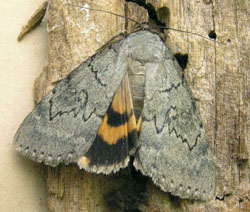 |
** 8779 serena Serene Underwing now confirmed (ME). The head and collar and abdomen are brown while the thorax is grey. The am and pm lines are thin but very dark and distinct on an otherwise drab, almost uniformly olive-grey forewing. The black marginal band of the lower wings is indented at the center, and the relatively narrow, deep yellow median band parallels this indentation. Basal hairs are brown. Catocala serena courtesy of Carroll Rudy, July 28, Calumet County, Wisconsin. |
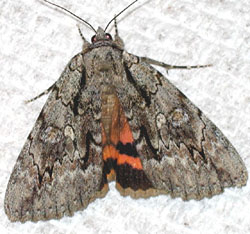
| #8778 Catocala habilis; wingspan: 55-65mm: Large thoracic "M" and "pork chop" shaped, light subreniform spot becoming very dark in constriction at juncture with narrow, dark, distinct pm line. Pm line outwardly lined with narrow suffusion of white scales, then broader brown scaled band, another broader suffusion of white up to regular dentation of subterminal line. Always significant "bleeding" of yellow-orange to salmon scales into hw fringes. Large reniform spot has brown center, faintly edged with black, then white, then black again. |
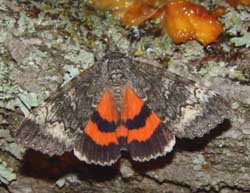
| #8817 briseis unconfirmed ; Briseis Underwing; wingspan: 60-70mm: Fws predominantly mottled dark-grey-brown with some lighter areas 1) between postmedial, subterminal lines, 2) at very base of antemedial, postmedial lines along i. m., and 3) over subreniform spot running diagonally toward costa. Pm lines without greatly elongated and sharly pointed "teeth" near apex. Hw fringe white, unbroken, inner black band (fairly even) reaches i. m.. |
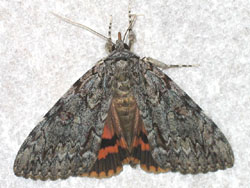
| #8795 Catocala palaeogama ; wingspan: 60-70mm. Subreniform spot closed, does not approach pm line, is smaller than in C. habilis. All forms have characteristic orange, heavily barred fringe to apex, and irregular bands on hws. Hw basal median area heavily suffused with dark brown to black scales. Dark bar in outer half of median area, paralleling i. m. halfway between i. m. and light, closed subreniform spot. Joe Garris photo. |
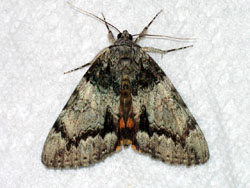
| #8795 Catocala palaeogama form phalanga; wingspan: 60-70mm. In this form, fw basal area and subterminal area are very dark against a much lighter background. Dark bar in the outer half of the median area, paralleling the inner margin halfway between the inner margin and the light, closed subreniform spot is especially evident. Joe Garris image. |
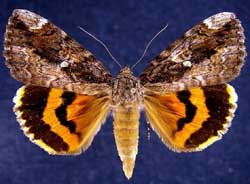
| ** 8770 Catocala innubens; Betrothed; 55-72mm. Forewing is mottled with white, grey and brown, and subrenifrom spot tends to be lighter in colour, although it is sometimes obscured by an indistinct blackish bar which runs from middle of basal/thorax connection to just below much lighter apex at outer margin.Jim Vargo image. |
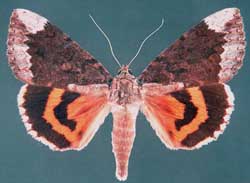
| ** 8770 Catocala innubens form scintillans; Betrothed; 55-72mm.In form scintillans most of the basal area (all but lower third) and all of the median area of the forewing is dark reddish brown. The area outside the pm line is grey. Vernon A Brou image. |
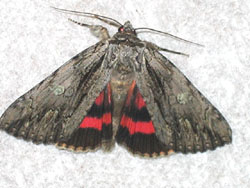
| ** 8851 Catocala coccinata; Scarlet; wingspan: 57-70mm: There are usually diffuse basal and anal dashes on an otherwise light grey, mottled fw. Hw fringe is white (often with some salmon scaling) and is heavily checked. I find "tooth" just below pair of very elongated "teeth" is much reduced and is quite rounded, usually allowing considerable room for lighter patch of scales. Dark bar crosses thorax. Reniform spot tends be to light, often with greenish cast. Joe Garris image. |
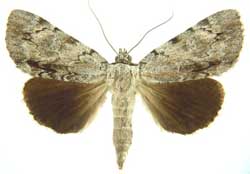
| miranda, Miranda Underwing; 37-45mm; unconfirmed; Fw: plain pale grey with very light and fine black lines, darker and wider near costa. Hw black with white fringe at the apex, turning to grey along the outer margin. Miranda is smaller than look-alike orba and miranda also has a dark bar just above the inner margin in the median area, projecting toward the anal angle. |
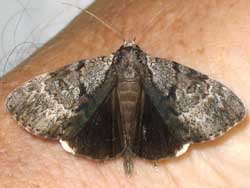
| Catocala andromedae, Gloomy Underwing, 40-50mm. Black underwings; dark grey fringe of hws, coupled with dark inner margin of fws help to identify this species. Very dark "flying saucer" shape, adjoining subreniform spot to midpoint of aml. Pml "teeth" short & blunt, outwardly edged with white. Subterminal line also outwardly edged with white. |
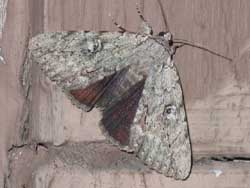
| ** 8781 judith, Judith's Underwing, 45-55mm; Smaller "black" underwings. Fw uniform light grey with thin, only slightly darkened am, median & pm lines. No darkened dashes (slight anal dash) or transverse lines. Reniform area slightly darkened while area just before subterminal line is a bit lighter. Note absence of hw white fringe. |
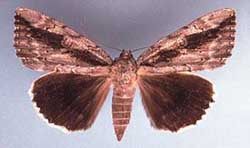
| ** 8782 Catocala flebilis; Mournful, 54-65mm. Diffuse black band runs from basal area to outer margin just below apex, interrupted by pale grey subreniform spot. Reniform spot filled with brown; additional brown outside pm line. No anal dash as there is in angusi. Hws have white fringe. J. K. Adams image. |
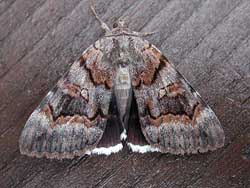
| ** 8773 Catocala epione , yes; Epione Underwing, 55-65mm. Pml squared & has brown band and then light band just outside the line. Hw: black with pure white fringe with no barring. John Himmelman image. |
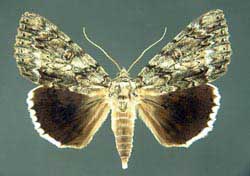
| Catocala ulalume, Ulalume Underwing, (wingspan: 65mm). Fw mottled light to dark grey, no strongly contrasting lines, dashes, bars. Aml ends at im in very light coloured crescent, close to pml. Open subrenifrom spot light coloured, "comma" shaped with triangular, somewhat bulbous head. Aml: short, thin, slightly humped dark line through midpoint. Hw black, fringe pure white, thin, pointed checking. |
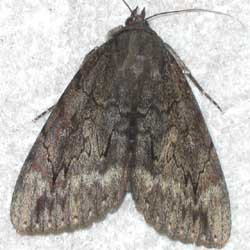
| Catocala residua, Residua Underwing, yes, 58-73mm, Distinguished from C. obscura by grey hw fringe of residua. C. obscura has white to off-white fringe, tends to be less common in northern portions of its range. Fw subterminal line/area of C. residua tends to be pale as is its open, elongated subreniform spot. Devoid of significant markings except for hint of dark bar running from basal area through reniform spot to om just below apex. |
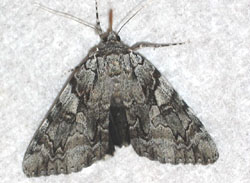
| Catocala dejecta; Dejected; 56-73mm. Pale grey patch from reniform & subreniform juncture to costal margin is diagnostic. Note open, light "pork chop" shape of subreniform spot. Two "teeth" in pml above subreniform spot relatively short, blunt. Upper portion of aml thick, black; lower half: light rounded lobes outlined in black. Hw fringe white with black wing veins extending like "teeth". |
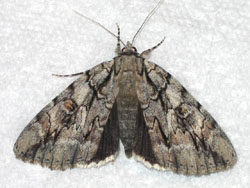
| Catocala retecta; 60-75mm. Note light coloured, elongated & open subreniform spot which interrupts dark, diffuse ark running through center of wing from basal area (body-wing juncture) to fw apex. Center of reniform spot brown; brown area just below costa running to inner margin just outside pm line. Off-white hindwing fringe only lightly checked along wing veins. |
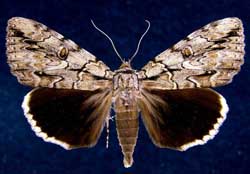
| Catocala luctuosa, Underwing, 70mm. Fw light grey (yellowish tint) clearly marked with a basal dash that continues with another dash through the am line, followed by another anal dash almost forming bar parallel to im. Hw fringe white, lightly barred at veins. Fw pml "teeth" elongated and dark, continuing dark dar emanating from om just below apex. |
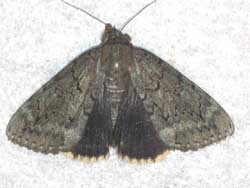
| ** 8784 obscura now confirmed (ME); Obscure Underwing, 60-72mm, Dull, grey fws, usually void of significant dashes or streaks. Am, median and pm lines faint; subterminal line region slightly paler than rest of fw. Hw fringe off-white, lightly checked on veins. Joe Garris photo. |
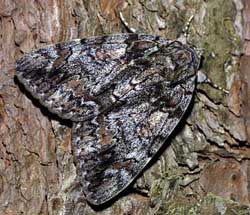
| ** 8794
Catocala lacrymosa;
Tearful Underwing, 60-82mm.
Fw highly variable with mixture of black, brown
(wing tips and outside postmedial line) and dark grey scaling.
Usually whitish crescents, along the inner margin at
base of am & pm lines. |
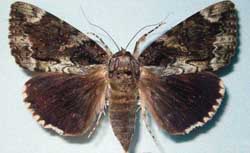
| ** 8794
Catocala lacrymosa;
Tearful Underwing, 60-82mm.
Form paulina: lighter grey post median area & area along and parallel to inner margin, in sharp contrast to
darker basal median areas. |
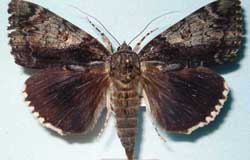
| ** 8794
Catocala lacrymosa;
Tearful Underwing, 60-82mm. |
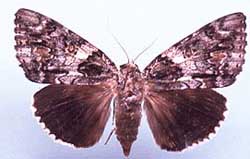
| ** 8794
Catocala lacrymosa;
Tearful Underwing, 60-82mm. |
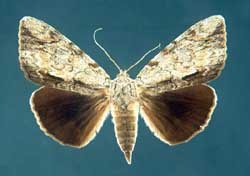
| ** 8791
Catocala insolabilis unconfirmed;
Inconsolable, wingspan: 65-75mm.
Fw light grey with blackish shading along inner
margin. Antemedial and postmedial lines thin.
Hw fringe is very narrow and grey, becoming whiter toward
the apex.
The ventral surface clearly distinguishes insolabis, being almost
completely black except for some white in the basal area. |
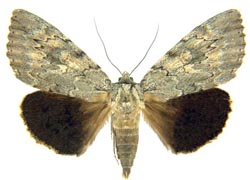
| ** 8780 Catocala robinsoni; 70-80mm; Fws relatively plain pale grey. Female has basal dash, absent in male. Currata French, 1882, is female form, having weak basal dash. Rare form missouriensis Schwarz, 1915, has dark, broad bar extending from basal area to om just below apex. Lighter grey rnfm and subrnfm spots break bar in missouriensis, found from PA to FL. White fringe on hindwings; prominent bands on ventral surface. |
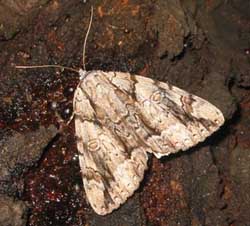
| ** 8792 Catocala vidua; Widow; 70-80mm. Fw ground colour light grey. Distinguishing dark arc runs through top of reniform spot to just below apex. Heavy, dark anal, basal dashes, connecting to dark median bar, running parallel to i. m.. The am line is thick and black in its upper half. Reniform spot consists of two almost concentric irregular ovals. Subreniform spot light, open, but constricted as it meets pm line. Hw black with broad, white fringe, lightly interrupted. |
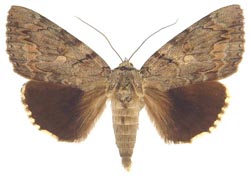
| Catocala agrippina 75-85mm; male fws: grey-black with some reddish brown (distinguishing characteristic); am & pm lines black, darker toward costa, much lighter near inner margin. Reniform indistinct, brown; sub-reniform almost obsolete, lighter than surrounding areas. Hws black, with greyish hairs at base & im. Fringe white, only partly cut with black at vein terminations. Female with more distinct markings. |
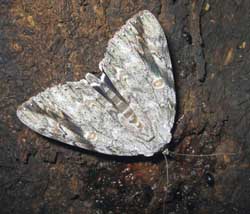
| ** 8793 Catocala maestosa SM, Sad Underwing, 78-98mm. Maesotsa quite similar to, although usually larger than, vidua. Both have dark arc from costa, above reniform spot, to outer margin just below apex. Maesotsa, however, lacks dark bar, found on vidua, parallel to inner margin. Reniform spot is brown and there is brown shading just outside the postmedial line. The hindwing fringe is white, narrow and heavily barred. |
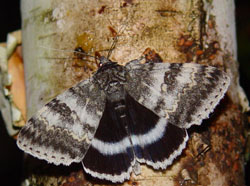
| ** 8803 Catocala relicta
;
Forsaken, White, Relict; 70-80mm:
Considerable variation with regard to black/white
concentrations on fws. |
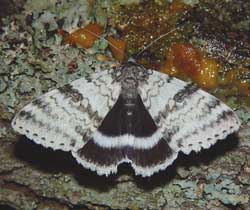
| ** 8803 Catocala relicta ; Forsaken, White, Relict; 70-80mm: Considerable variation with regard to black/white concentrations on fws. Form clara: basal and subterminal areas predominantly white.Typical specimens have basal and subterminal areas with blackish scales. Black hws, with brilliant even white inner band and white fringe, are distinctive. June until October. |
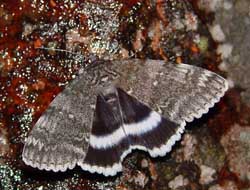
| ** 8803 Catocala relicta ; Forsaken, White, Relict; 70-80mm: Considerable variation with regard to black/white concentrations on fws. Form phrynia: evenly dusted with grey over entire forewing. Typical specimens have basal and subterminal areas with blackish scales. Black hws, with brilliant even white inner band and white fringe, are distinctive. June until October, poplars and willows |
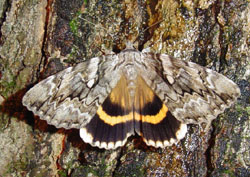
| ** 8802 Catocala cerogama; Yellow-Banded; 70-80mm. Several different forms. Pm line distinct, dark and has elongate pair of projections. Pm and am lines meet inner margin in relative proximity. Closed subreniform spot lighter than surrounding areas, shaped a bit like an arrowhead with point toward body. Hws are distinctive. Jean-Benoît Duval image. |
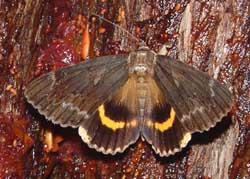
| ** 8802 Catocala cerogama; Yellow-Banded; 70-80mm.Form ruperti: Forewings are almost uniform grey-brown with white scales outlining subterminal line. The hindwings are distinctive. Tim Dyson image. |
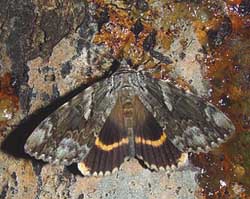
| ** 8802 Catocala cerogama; Yellow-Banded; 70-80mm.Form bunkeri: Forewings are dark in median and basal areas. Hw golden band is reduced in thickness. Basal hairs are brown instead of yellow. The hindwings are distinctive. Tim Dyson image. |
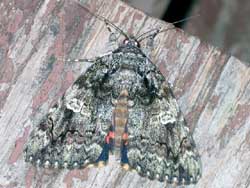
| ** 8801
Catocala ilia; Ilia;
wingspan: 65-82mm |
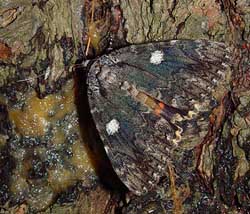
| ** 8801 Catocala ilia; Ilia; form conspicua.In this form the entire reniform spot is heavily suffused with white scaling on an otherwise darker ground colour. Hence the form name "conspicua". Tim Dyson image. |
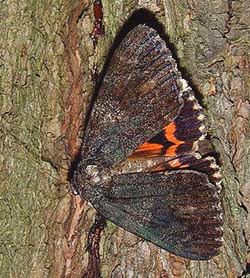
| ** 8801 Catocala ilia; Ilia; form satanas.In this melanic form the entire forewing, including the reniform spot is very dark. Hence the form name "satanas". The dark basal streak is still evident on this form. Tim Dyson image. |
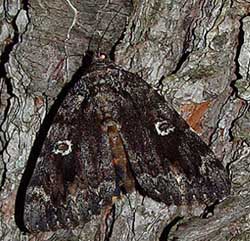
| ** 8801 Catocala ilia; Ilia; form normani.In this semi-melanic form the entire forewing, excluding the reniform spot, is relatively dark. The brownish, kidney-shaped center of the reniform spot is outlined in white. Tim Dyson image. |
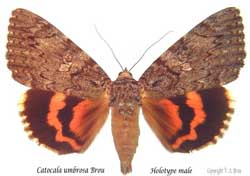
| ** 8857.1 Catocala umbrosa; mm; Double brown am line, inward line fainter, filled with off white; reniform spot brown center outlined in black , off white and black again; subreniform, large, pale brown, closed. Pm line wit htwo elongated upper teeth, next tooth reduced, next two progressively longer, rounded, final lobe rounded and shorter. HW with dark scaling/hairs in basal median area along im |
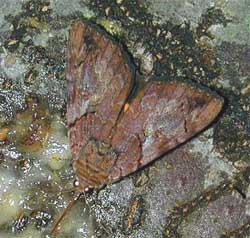
| Catocala muliercula; Little Wife Underwing; Dark, distinct upper half am line runs obliquely toward anal angle, turns in two lobes to im; basal area dark brown; inner brown kidney shaped reniform spot, oulined in black then light then black again; open, lighter subreniform spot with light area from it to costa; median area greyish-blue-brown; subterminal area brown; terminal area greyish-blue-brown; lighter patch at apex. Hw dark bands thick, much dark scaling in basal area covering two thirds of region, joining inner black band to im. |
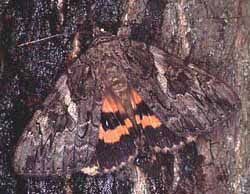
| ** 8771 Catocala piatrix ; Penitent, wingspan: 68-84mm. Fw: light-colored band/bar extending from light coloured, triangular subreniform spot along am line to costa. Brown, kidney-shaped reniform spot surrounded in pale grey, outlined in black, usually with distinct black along wing veins in a dark area outside the reniform spot. Hw: fringe lightly barred; lighter in color than deeper orange on rest of wing. |
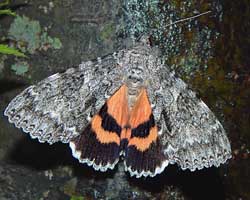
| ** 8805 unijuga confirmed by Jonathan Willey; Once-married; wingspan: 70-90mm. Fairly wide HW black inner band (almost reaching inner margin); very distinctive patterning in fw. Meskei tend to have narrower band and dustier (less distinct) looking forewing. Semirelicta tend to have inner bands terminating well before inner margins. Note very white fringe on both fws hws. Carroll Rudy image. |
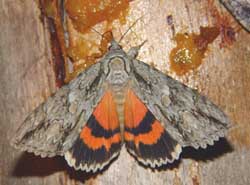
| ** 8806 Catocala parta; Mother Underwing, 70-85mm. The black dashes in the basal, subapical and anal areas help to identify this species. The hindwings may be yellow to yellowish-orange but more often are salmon-red. Note the face-head-like markings on the thorax. In the hindwing, the first (nearest the apex) black protrusion into the white fringe is "noticeably" larger than the others. |
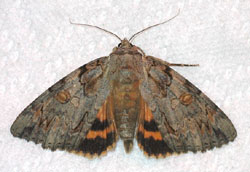
| ** 8798 Catocala neogama; wingspan 70-85mm. Brown head, thorax, larger size as compared to C. palaeogama. Neogama tend to be slightly smaller than subnata, have darker grey brown fws with more pronounced markings. Examination of hind tibia needed for id. Neogama's: flattened, unevenly, sparsely spined; subnata's: cylindrical, spines dense, uniform in distribution. Joe Garris photo. |
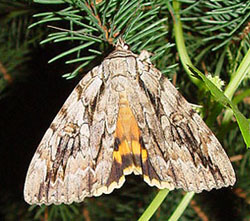
| ** 8797 Catocala subnata; Youthful Underwing: 75-90mm. Fws greyish white with blue-grey and light brown scales, usually with hws brighter yellow than those of neogama. Neogama usually have basal dash; absent in male subnata, but present in females. Magnification of hind tibia needed for id: subnata: cylindrical hind tibia; neogama: compressed or flattened hind tibia. subnata: ventral surface of tibia densely covered with evenly distributed spines; neogama: ventral surface of tibia sparsely covered. |
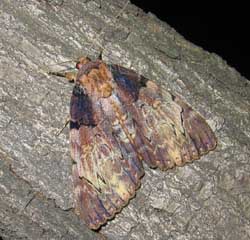
| ** 8796 Catocala nebulosa; Clouded; wingspan 75-86mm: Prominent dark brown upper-half-basal patch that extends to and ends at am line. Apical area also tends to be brown, much darker than median area but not as dark as basal patch. The anal angle also has the darker brown scaling. The pm line is distinct near costa and inner margin, but becomes weak between the two. It meets inner margin in relative close proximity to am line. Closed subreniform spot is large and connects to the pm line via a thin line. |
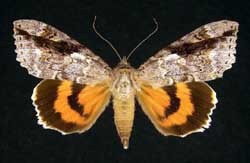
| ** 8804 C. marmorata;
Marbled; wingspan 85-95mm |
Medium-Large Pink Underwings: Wingspans: 70-95mm
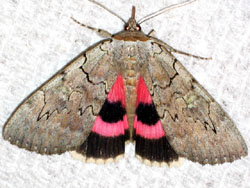
| ** 8833 concumbens Sleepy Underwing or Pink Underwing (wingspan: 60-75mm). This brown thoracic collar is quite evident in this image as is the interruption in the pm line by the open subreniform spot. The white hindwing fringe is only lightly checked on the wing veins. The vibrant pink bans are distinct in colour and also in their relatively smooth contour. |
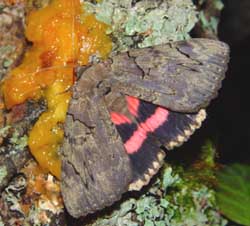
| ** 8832 Catocala cara; Darling; wingspan 70-85mm. Deep maroon almost purple cast to fws, mixed with very pale green. Lower half of am and pm lines barely visible. No distinctive bars or dashes. Two upper "teeth" on pm line thin and long. Hw bands pink. Heavy black checking on off-white hw fringe. Relatively thick black hw median band almost reaches im which is usually heavily adorned with dark hairs. Tim Dyson image. |
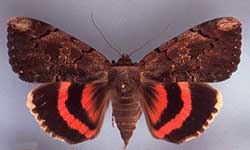
| ** Catocala carissima; wingspan 70-85mm. Distinct light grey brown area at fw apex, preceded just inside pm line by slightly darker patch. Am and pm lines sharp and dark. Hw inner black band wide, complete, merges with extensive grey-black scaling along im. Hw fringe cream coloured. |
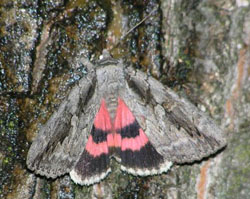
|
** 8834 amatrix Sweetheart Underwing; (wingspan 75-95mm). Very skittish, frequently hides in caves, under bridges, under tree bark, etc. by day, resting with head down. Hw patterning and colouration similar to that of C. concumbens, but large size (wingspan 75-95mm) and dark bar running from basal area to just below apex distinguishes C. amatrix. See large Catocala amatrix courtesy of Joan F. Rickert. |
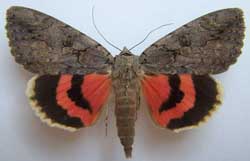
|
** 8834 amatrix form selecta
Sweetheart Underwing; (wingspan 75-95mm) |
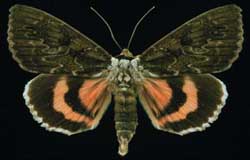
|
** 8834 amatrix form hesseli
Sweetheart Underwing; (wingspan 75-95mm) |
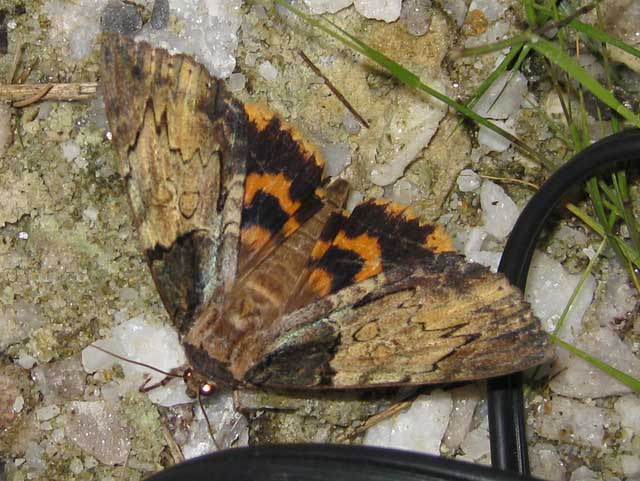
Catocala nebulosa, Abingdon, Harford County, Maryland, September 12, 2009,
photographed at uv light in power line cut, courtesy of Kevin Harkins.
Enjoy some of nature's wonderments, giant silk moth cocoons. These cocoons are for sale winter and fall. Beautiful Saturniidae moths will emerge the following spring and summer. Read Actias luna rearing article. Additional online help available.
Use your browser "Back" button to return to the previous page.
This page is brought to you by Bill Oehlke and the WLSS. Pages are on space rented from Bizland. If you would like to become a "Patron of the Sphingidae/Catocala Sites", contact Bill.
Please send sightings/images to Bill. I will do my best to respond to requests for identification help.

|
butterfly to the left, a link to many worldwide insect sites. |
Use your browser "Back" button to return to the previous page.